Porter-Cable PC1800L, PCL180L, 90546221 User Manual
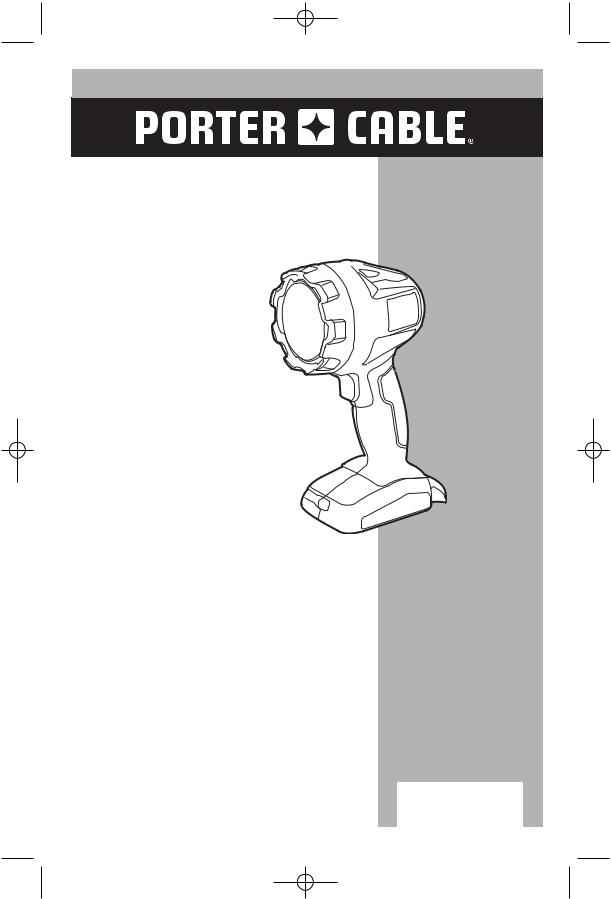
90546221 pc1800l pcl180l 1/5/09 12:34 PM Page 1
18v Flashlight
Lampe de poche 18v
Linterna de 18v
Instruction manual
Manuel d'instructions
Manual de'instrucciones
www.portercable.com
INSTRUCTIVO DE OPERACIÓN, CENTROS DE SERVICIO Y PÓLIZA DE GARANTÍA.
 ADVERTENCIA: LÉASE ESTE INSTRUCTIVO ANTES DE USAR EL PRODUCTO.
ADVERTENCIA: LÉASE ESTE INSTRUCTIVO ANTES DE USAR EL PRODUCTO.
Batteries and chargers sold separately
CATALOG NUMBER
PC1800L
PCL180L

90546221 pc1800l pcl180l 1/5/09 12:34 PM Page 2
General Power Tool Safety Warnings
Read all safety warnings and instructions. Failure to follow the warnings and instructions may result in electric shock, fire and/or serious injury.
Save all warnings and instructions for future reference.
The term “power tool” in the warnings refers to your mains-operated (corded) power tool or battery-operated (cordless) power tool.
1)Work area safety
a)Keep work area clean and well lit. Cluttered or dark areas invite accidents.
b)Do not operate power tools in explosive atmospheres, such as in the presence of flammable liquids, gases or dust. Power tools create sparks which may ignite the dust or fumes.
c)Keep children and bystanders away while operating a power tool. Distractions can cause you to lose control
2)Electrical safety
a)Power tool plugs must match the outlet. Never modify the plug in any way. Do not use any adapter plugs with earthed (grounded) power tools. Unmodified plugs and matching outlets will reduce risk of electric shock
b)Avoid body contact with earthed or grounded surfaces such as pipes, radiators, ranges and refrigerators. There is an increased risk of electric shock if your body is earthed or grounded.
c)Do not expose power tools to rain or wet conditions. Water entering a power tool will increase the risk of electric shock
d)Do not abuse the cord. Never use the cord for carrying, pulling or unplugging the power tool. Keep cord away from heat, oil, sharp edges or moving parts.
Damaged or entangled cords increase the risk of electric shock.
e)When operating a power tool outdoors, use an extension cord suitable for outdoor use. Use of a cord suitable for outdoor use reduces the risk of electric shock.
f)If operating a power tool in a damp location is unavoidable, use a ground fault circuit interrupter (GFCI) protected supply. Use of a GFCI reduces the risk of electric shock.
3)Personal safety
a)Stay alert, watch what you are doing and use common sense when operating a power tool. Do not use a power tool while you are tired or under the influence of drugs, alcohol or medication. A moment of inattention while operating power tools may result in serious personal injury.
b)Use personal protective equipment. Always wear eye protection. Protective equipment such as dust mask, non-skid safety shoes, hard hat, or hearing protection used for appropriate conditions will reduce personal injuries.
c)Prevent unintentional starting. Ensure the switch is in the off-position before connecting to power source and/or battery pack, picking up or carrying the tool. Carrying power tools with your finger on the switch or energizing power tools that have the switch on invites accidents.
d)Remove any adjusting key or wrench before turning the power tool on. A wrench or a key left attached to a rotating part of the power tool may result in personal injury.
e)Do not overreach. Keep proper footing and balance at all times. This enables better control of the power tool in unexpected situations.
f)Dress properly. Do not wear loose clothing or jewellery. Keep your hair, clothing and gloves away from moving parts. Loose clothes, jewellery or long hair can be caught in moving parts.
g)If devices are provided for the connection of dust extraction and collection facilities, ensure these are connected and properly used. Use of dust collection can reduce dust-related hazards.
4)Power tool use and care
a)Do not force the power tool. Use the correct power tool for your application.
2

90546221 pc1800l pcl180l 1/5/09 12:34 PM Page 3
The correct power tool will do the job better and safer at the rate for which it was designed.
b)Do not use the power tool if the switch does not turn it on and off. Any power tool that cannot be controlled with the switch is dangerous and must be repaired.
c)Disconnect the plug from the power source and/or the battery pack from the power tool before making any adjustments, changing accessories, or storing power tools. Such preventive safety measures reduce the risk of starting the power tool accidentally.
d)Store idle power tools out of the reach of children and do not allow persons unfamiliar with the power tool or these instructions to operate the power tool.
Power tools are dangerous in the hands of untrained users.
e)Maintain power tools. Check for misalignment or binding of moving parts, breakage of parts and any other condition that may affect the power tool’s operation. If damaged, have the power tool repaired before use. Many accidents are caused by poorly maintained power tools.
f)Keep cutting tools sharp and clean. Properly maintained cutting tools with sharp cutting edges are less likely to bind and are easier to control.
g)Use the power tool, accessories and tool bits etc., in accordance with these instructions, taking into account the working conditions and the work to be performed. Use of the power tool for operations different from those intended could result in a hazardous situation.
5)Battery tool use and care
a)Recharge only with the charger specified by the manufacturer. A charger that is suitable for one type of battery pack may create a risk of fire when used with another battery pack.
b)Use power tools only with specifically designated battery packs. Use of any other battery packs may create a risk of injury and fire.
c)When battery pack is not in use, keep it away from other metal objects like paper clips, coins, keys, nails, screws, or other small metal objects that can make a connection from one terminal to another. Shorting the battery terminals together may cause burns or a fire.
d)Under abusive conditions, liquid may be ejected from the battery, avoid contact. If contact accidentally occurs, flush with water. If liquid contacts eyes, additionally seek medical help. Liquid ejected from the battery may cause irritation or burns.
6)Service
a)Have your power tool serviced by a qualified repair person using only identical replacement parts. This will ensure that the safety of the power tool is maintained.
IMPORTANT SAFETY
INSTRUCTIONS FOR FLASHLIGHTS
 WARNING: WHENUSINGELECTRICAPPLIANCES,BASIC PRECAUTIONSSHOULDALWAYSBEFOLLOWED,INCLUDINGTHE FOLLOWING:
WARNING: WHENUSINGELECTRICAPPLIANCES,BASIC PRECAUTIONSSHOULDALWAYSBEFOLLOWED,INCLUDINGTHE FOLLOWING:
•READ ALL THE INSTRUCTIONS BEFORE USING THE APPLIANCE.
•To reduce the risk of injury, close supervision is necessary when an appliance is used
near children.
•Only use attachments recommended or sold by the manufacturer.
•To reduce the risk of electrical shock, do not put light in water or other liquid. Do not place or store appliance where it can fall or be pulled into a tub or sink.
•Use only the charger supplied by the manufacturer to recharge.
•During or immediately after use, don’t lay light flat on lens surface.
•Replace broken bulb in a well ventilated area.
•Don’t touch lens surface when bulb is lit or immediately after use.
•Handle light with care around any flammable surface.
•Do not expose light or charger to wet or damp areas. Do not expose light or charger to rain or snow.
3
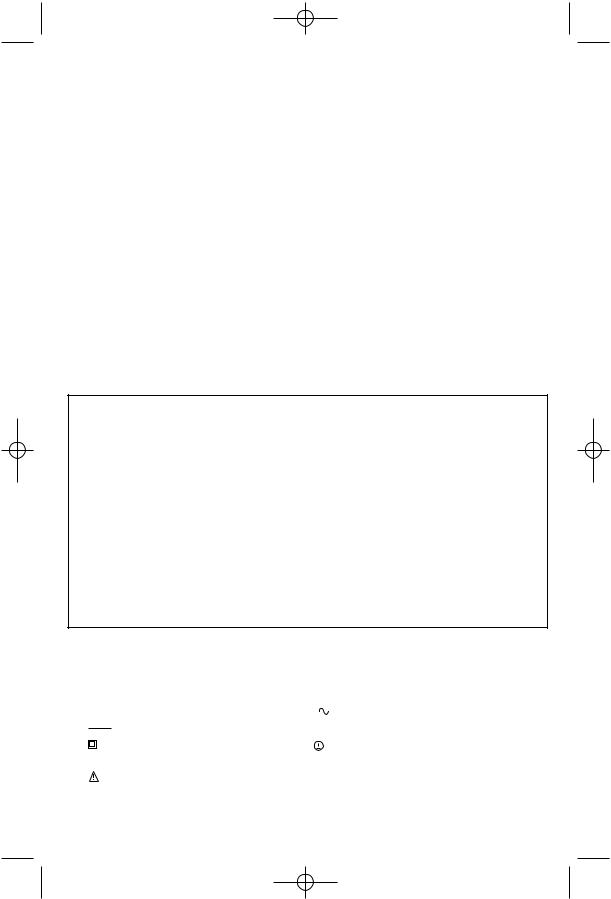
90546221 pc1800l pcl180l 1/5/09 12:34 PM Page 4
•Do not wash light or charger with water or allow water to get inside light or charger.
•While light is in use, do not cover with cloth or other flammable materials due to increased risk of fire.
•Do not operate without lens cover assembly attached.
•For household use only.
 WARNING: Burn hazard. Do not operate flashlight or charger near flammable liquids or in gaseous or explosive atmospheres. Internal sparks may ignite fumes causing personal injury.
WARNING: Burn hazard. Do not operate flashlight or charger near flammable liquids or in gaseous or explosive atmospheres. Internal sparks may ignite fumes causing personal injury.
 WARNING: Shock Hazard. Always remove battery before replacing the lamp. Replace bulb with same type rated KPR 18V 0.3A. Such preventative safety measures reduce the risk of personal injury.
WARNING: Shock Hazard. Always remove battery before replacing the lamp. Replace bulb with same type rated KPR 18V 0.3A. Such preventative safety measures reduce the risk of personal injury.
 WARNING: The lens gets very hot during use. To reduce the risk of burns, do not touch hot lens. To reduce the risk of fire, keep away from combustible materials while in operation.
WARNING: The lens gets very hot during use. To reduce the risk of burns, do not touch hot lens. To reduce the risk of fire, keep away from combustible materials while in operation.
 CAUTION: When not in use, place tool on its side on a stable surface where it will not cause a tripping or falling hazard. Some tools with large battery packs will stand upright on the battery pack but may be easily knocked over.
CAUTION: When not in use, place tool on its side on a stable surface where it will not cause a tripping or falling hazard. Some tools with large battery packs will stand upright on the battery pack but may be easily knocked over.
SAVE THESE INSTRUCTIONS
SAFETY GUIDELINES - DEFINITIONS
It is important for you to read and understand this manual. The information it contains relates to protecting YOUR SAFETY and PREVENTING PROBLEMS. The symbols below are used to help you recognize this information.
 DANGER: Indicates an imminently hazardous situation which, if not avoided, will result in death or serious injury.
DANGER: Indicates an imminently hazardous situation which, if not avoided, will result in death or serious injury.
 WARNING:Indicates a potentially hazardous situation which, if not avoided, could result in death or serious injury.
WARNING:Indicates a potentially hazardous situation which, if not avoided, could result in death or serious injury.
 CAUTION: Indicates a potentially hazardous situation which, if not avoided, may result in minor or moderate injury.
CAUTION: Indicates a potentially hazardous situation which, if not avoided, may result in minor or moderate injury.
CAUTION: Used without the safety alert symbol indicates a potentially hazardous situation which, if not avoided, may result in property damage.
SYMBOLS
The label on your tool may include the following symbols. The symbols and their
definitions are as follows: |
|
|
|
|
||
V.................. |
volts |
A .................. |
amperes |
|||
Hz................ |
hertz |
W.................. |
watts |
|||
min .............. |
minutes |
no ................ |
alternating current |
|||
|
|
direct current |
no load speed |
|||
|
|
|||||
|
................ |
Class II Construction |
|
|
|
earthing terminal |
|
|
(double insulated) |
|
|
................ |
|
|
|
|
|
|
||
|
|
|
|
|
||
|
|
|
|
|
|
|
|
|
safety alert symbol |
../minorrpm .... |
revolutions or reciprocations |
||
|
.............. |
|
|
|
|
|
per minute
4
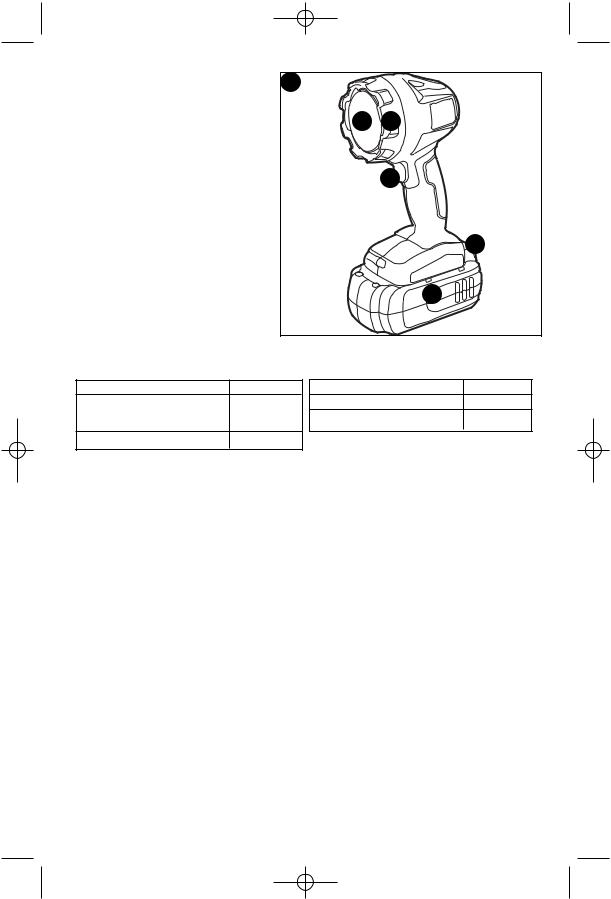
90546221 pc1800l pcl180l 1/5/09 12:34 PM Page 5
FUNCTIONAL DESCRIPTION |
A |
|
Figure A |
||
|
||
1. On/Off Switch |
|
3 2
2. |
Lens Holder |
|
3. |
Lens |
|
4. |
Battery (not included) |
|
5. |
Battery Release Button |
|
|
(on battery) |
5 |
|
|
4 |
This product can accept any of the batteries and chargers listed in the chart below.
LI-ION Battery Packs and Chargers
Description |
Cat. # |
Battery: LI-ION 18V |
PC18BL |
|
PC18BLX |
Charger: LI-ION |
PC18BLEX |
PCLMVC |
NI-CD Battery Packs and Chargers
Description |
Cat. # |
Battery: NI-CD 18V |
PC18B |
Charger: NI-CD |
PCMVC |
IMPORTANT SAFETY INSTRUCTIONS FOR BATTERY CHARGERS
SAVE THESE INSTRUCTIONS: This manual contains important safety instructions for battery chargers.
•Before using charger, read all instructions and cautionary markings on charger, battery pack, and product using battery pack.
 WARNING: Shock hazard. Do not allow any liquid to get inside charger.
WARNING: Shock hazard. Do not allow any liquid to get inside charger.
 CAUTION: Burn hazard. To reduce the risk of injury, charge only designated Porter-Cable batteries. Other types of batteries may burst causing personal injury and damage.
CAUTION: Burn hazard. To reduce the risk of injury, charge only designated Porter-Cable batteries. Other types of batteries may burst causing personal injury and damage.
 CAUTION: Under certain conditions, with the charger plugged in to the power supply, the charger can be shorted by foreign material. Foreign materials of a conductive nature such as, but not limited to, steel wool, aluminum foil, or any buildup of metallic particles should be kept away from charger cavities. Always unplug the charger from the power supply when there is no battery pack in the cavity. Unplug charger before attempting to clean.
CAUTION: Under certain conditions, with the charger plugged in to the power supply, the charger can be shorted by foreign material. Foreign materials of a conductive nature such as, but not limited to, steel wool, aluminum foil, or any buildup of metallic particles should be kept away from charger cavities. Always unplug the charger from the power supply when there is no battery pack in the cavity. Unplug charger before attempting to clean.
•DO NOT attempt to charge the battery pack with any chargers other than the ones in this manual. The charger and battery pack are specifically designed to work together.
•These chargers are not intended for any uses other than charging designated
Porter-Cable rechargeable batteries. Any other uses may result in risk of fire, electric shock or electrocution
•Do not expose charger to rain or snow.
5

90546221 pc1800l pcl180l 1/5/09 12:34 PM Page 6
•Pull by plug rather than cord when disconnecting charger. This will reduce risk of damage to electric plug and cord.
•Make sure that cord is located so that it will not be stepped on, tripped over, or otherwise subjected to damage or stress.
•Do not use an extension cord unless it is absolutely necessary. Use of improper extension cord could result in risk of fire, electric shock, or electrocution.
•An extension cord must have adequate wire size (AWG or American Wire Gauge) for safety. The smaller the gauge number of the wire, the greater the capacity of the cable, that is 16 gauge has more capacity than 18 gauge. When using more than one extension to make up the total length, be sure each individual extension contains at least the minimum wire size.
•Do not place any object on top of charger or place the charger on a soft surface that might block the ventilation slots and result in excessive internal heat. Place the charger in a position away from any heat source. The charger is ventilated through slots in the top and the bottom of the housing.
•Do not mount charger on wall or permanently affix charger to any surface. The charger is intended to use on a flat, stable surface (i.e., table top, bench top).
•Do not operate charger with damaged cord or plug — have them replaced immediately.
•Do not operate charger if it has received a sharp blow, been dropped, or otherwise damaged in any way. Take it to an authorized service center.
•Do not disassemble charger; take it to an authorized service center when service or repair is required. Incorrect reassembly may result in a risk of electric shock, electrocution or fire.
•Disconnect the charger from the outlet before attempting any cleaning. This will reduce the risk of electric shock. Removing the battery pack will not reduce this risk.
•NEVER attempt to connect 2 chargers together.
•The charger is designed to operate on standard household electrical power (120 Volts). Do not attempt to use it on any other voltage.
SAVE THESE INSTRUCTIONS
IMPORTANT SAFETY INSTRUCTION FOR BATTERY PACKS
 WARNING: For safe operation, read this manual and manuals originally supplied with tool before using the charger.
WARNING: For safe operation, read this manual and manuals originally supplied with tool before using the charger.
The battery pack is not fully charged out of the carton. Before using the battery pack and charger, read the safety instructions below. Then follow charging procedures outlined.
•Do not incinerate the battery pack even if it is severely damaged or is completely worn out. The battery pack can explode in a fire. Toxic fumes and materials are created when lithium ion battery packs are burned.
•Do not charge or use battery in explosive atmospheres, such as in the presence of flammable liquids, gases or dust. Inserting or removing the battery from the charger may ignite the dust or fumes.
•If battery contents come into contact with the skin, immediately wash area with mild soap and water. If battery liquid gets into the eye, rinse water over the open eye for 15 minutes or until irritation ceases. If medical attention is needed, the battery electrolyte for Li-ion batteries is composed of a mixture of liquid organic carbonates and lithium salts. For Ni-Cd batteries it is a 25-35% solution of potassium hydroxide.
•Contents of opened battery cells may cause respiratory irritation. Provide fresh air. If symptoms persists, seek medical attention.
 WARNING: Burn hazard. Battery liquid may be flammable if exposed to spark or flame.
WARNING: Burn hazard. Battery liquid may be flammable if exposed to spark or flame.
6
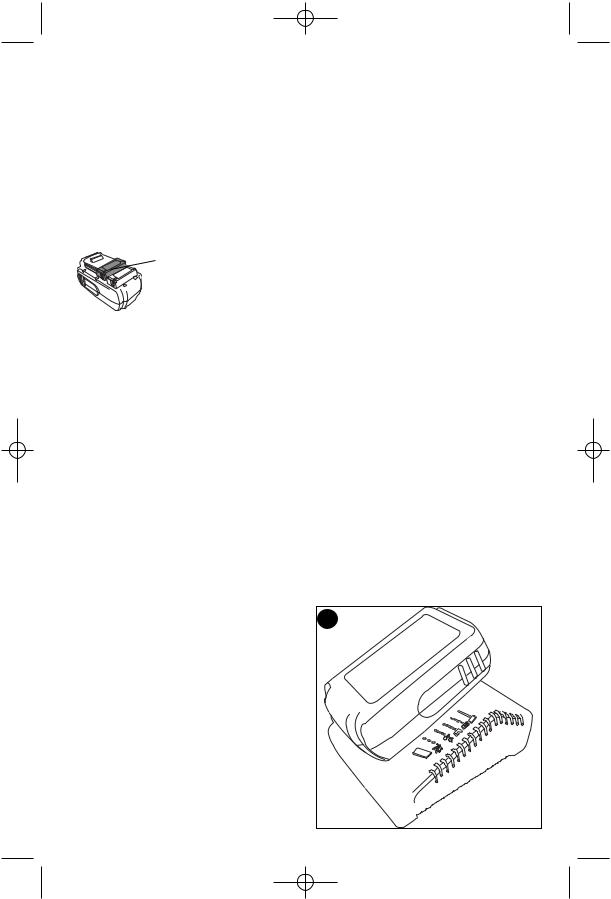
90546221 pc1800l pcl180l 1/5/09 12:34 PM Page 7
•Charge the battery packs only in Porter-Cable chargers.
•DO NOT splash or immerse in water or other liquids. This may cause premature cell failure.
•Do not store or use the tool and battery pack in locations where the temperature may reach or exceed 105°F (40C˚) (such as outside sheds or metal buildings in summer).
 WARNING: Never attempt to open the battery pack for any reason. If battery pack case is cracked or damaged, do not insert into charger. Do not crush, drop or damage battery pack. Do not use a battery pack or charger that has received a sharp blow, been dropped, run over or damaged in any way (i.e., pierced with a nail, hit with a hammer, stepped on). Damaged battery packs should be returned to service center for recycling.
WARNING: Never attempt to open the battery pack for any reason. If battery pack case is cracked or damaged, do not insert into charger. Do not crush, drop or damage battery pack. Do not use a battery pack or charger that has received a sharp blow, been dropped, run over or damaged in any way (i.e., pierced with a nail, hit with a hammer, stepped on). Damaged battery packs should be returned to service center for recycling.
BATTERY CAP INFORMATION
Battery Cap
Battery storage and carrying caps are provided for use whenever the battery is out of the tool or charger. Remove cap before placing battery in charger or tool.
 WARNING: Fire hazard. Do not store or carry battery so that metal objects can contact exposed battery terminals. For example, do not place battery in aprons, pockets, tool boxes, product kit boxes, drawers, etc., with loose nails, screws, keys, etc. Transporting batteries can possibly cause fires if the battery terminals inadvertently come in contact with conductive materials such as keys, coins, hand tools and the like. The US Department of Transportation Hazardous Material Regulations (HMR) actually prohibit transporting batteries in commerce or on airplanes (i.e., packed in suitcases and carry-on luggage) UNLESS they are properly protected from short circuits. So when transporting individual batteries, make sure that the battery terminals are protected and well insulated from materials that could contact them and cause a short circuit. NOTE: Lithium ion batteries should not be put in checked baggage.
WARNING: Fire hazard. Do not store or carry battery so that metal objects can contact exposed battery terminals. For example, do not place battery in aprons, pockets, tool boxes, product kit boxes, drawers, etc., with loose nails, screws, keys, etc. Transporting batteries can possibly cause fires if the battery terminals inadvertently come in contact with conductive materials such as keys, coins, hand tools and the like. The US Department of Transportation Hazardous Material Regulations (HMR) actually prohibit transporting batteries in commerce or on airplanes (i.e., packed in suitcases and carry-on luggage) UNLESS they are properly protected from short circuits. So when transporting individual batteries, make sure that the battery terminals are protected and well insulated from materials that could contact them and cause a short circuit. NOTE: Lithium ion batteries should not be put in checked baggage.
STORAGE RECOMMENDATIONS
1.The best storage place is one that is cool and dry away from direct sunlight and excess heat or cold.
2.Long storage will not harm the battery pack or charger. Under proper conditions LI-ION batteries, can be stored for 5 years or more.
CHARGING PROCEDURE
Porter-Cable chargers are designed to charge Porter-Cable battery packs in 30-60 minutes depending on the pack being charged.
1.Plug the charger into an appropriate outlet before inserting the battery pack.
2.Insert the battery pack into the charger
(figure B). |
B |
7
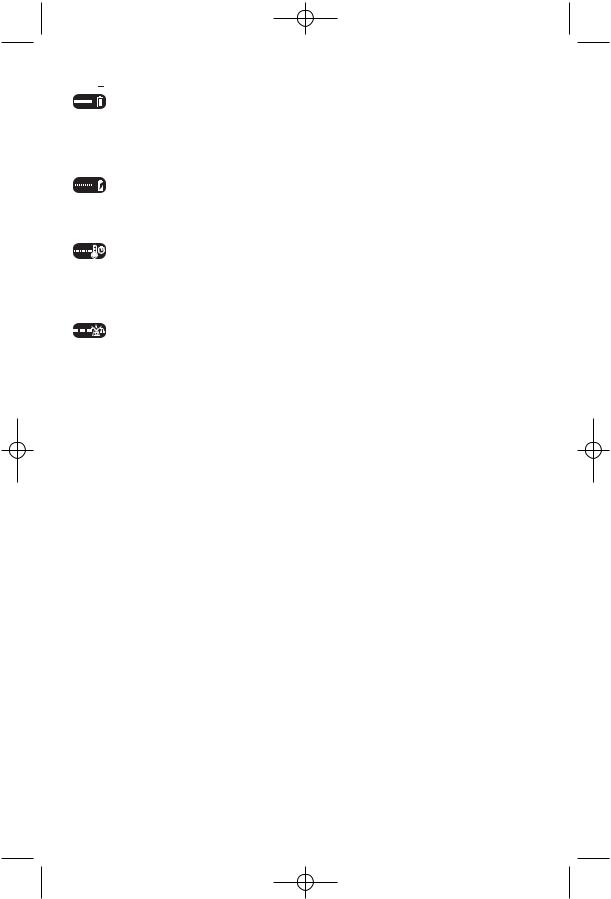
90546221 pc1800l pcl180l 1/5/09 12:34 PM Page 8
 3. The LED will flash indicating that the battery is being charged.
3. The LED will flash indicating that the battery is being charged.
4. The completion of charge is indicated by the LED remaining on continuously. The pack is fully charged and may be used at this time or left on the charger.
CHARGER DIAGNOSTICS
This charger is designed to detect certain problems that can arise with the battery packs or the power source. Problems are indicated by one LED flashing in different patterns.
BAD BATTERY
The charger can detect a weak or damaged battery. The LED flashes in the pattern indicated on the label. If you see this bad battery blink pattern, do not continue to charge the battery. Return it to a service center or a collection site for recycling.
HOT/COLD PACK DELAY
When the charger detects a battery that is excessively hot or excessively cold, it automatically starts a Hot/Cold Pack Delay, suspending charging until the
battery has normalized. After this happens, the charger automatically switches to the Pack Charging mode. This feature ensures maximum battery life. The light flashes in the pattern indicated on the label.
PROBLEM POWER LINE

 When the charger is used with some portable power sources such as generators or sources that convert DC to AC, the charger may temporarily suspend operation. The LED flashes in the pattern indicated on the label. This indicates that the power source is out of limits.
When the charger is used with some portable power sources such as generators or sources that convert DC to AC, the charger may temporarily suspend operation. The LED flashes in the pattern indicated on the label. This indicates that the power source is out of limits.
LEAVING THE BATTERY IN THE CHARGER
The charger and battery pack can be left connected with the LED glowing indefinitely. The charger will keep the battery pack fresh and fully charged. This charger features an automatic tune-up mode which equals or balances the individual cells in the battery pack to allow it to function at peak capacity. Battery packs should be tuned up weekly or whenever the battery no longer delivers the same amount of work. To use the automatic tune-up mode, place the battery pack in the charger and leave it for at least 8 hours.
IMPORTANT CHARGING NOTES
1.Longest life and best performance can be obtained if the battery pack is charged when the air temperature is between 65°F and 75°F (18°- 24°C). DO NOT charge the battery pack in an air temperature below +40°F (+4.5°C), or above +105°F (+40.5°C). This is important and will prevent serious damage to the battery pack.
2.The charger and battery pack may become warm to touch while charging. This is a normal condition, and does not indicate a problem. To facilitate the cooling of the battery pack after use, avoid placing the charger or battery pack in a warm environment such as in a metal shed, or an uninsulated trailer.
3.If the battery pack does not charge properly:
a.Check current at receptacle by plugging in a lamp or other appliance
b.Check to see if receptacle is connected to a light switch which turns power off when you turn out the lights.
c.Move charger and battery pack to a location where the surrounding air temperature is approximately 65°F - 75°F (18°- 24°C).
d.If charging problems persist, take the tool, battery pack and charger to your local service center.
4.The battery pack should be recharged when it fails to produce sufficient power on jobs which were easily done previously. DO NOT CONTINUE to use under these conditions. Follow the charging procedure. You may also charge a partially used pack whenever you desire with no adverse affect on the battery pack.
5.Foreign materials of a conductive nature such as, but not limited to, steel wool, aluminum foil, or any buildup of metallic particles should be kept away from charger cavities. Always unplug the charger from the power supply when there is no battery pack in the cavity. Unplug charger before attempting to clean.
6.Do not freeze or immerse charger in water or any other liquid.
 WARNING: Shock hazard. Do not allow any liquid to get inside charger. Never attempt to open the battery pack for any reason. If the plastic housing of the battery pack breaks or cracks, return to a service center for recycling.
WARNING: Shock hazard. Do not allow any liquid to get inside charger. Never attempt to open the battery pack for any reason. If the plastic housing of the battery pack breaks or cracks, return to a service center for recycling.
8
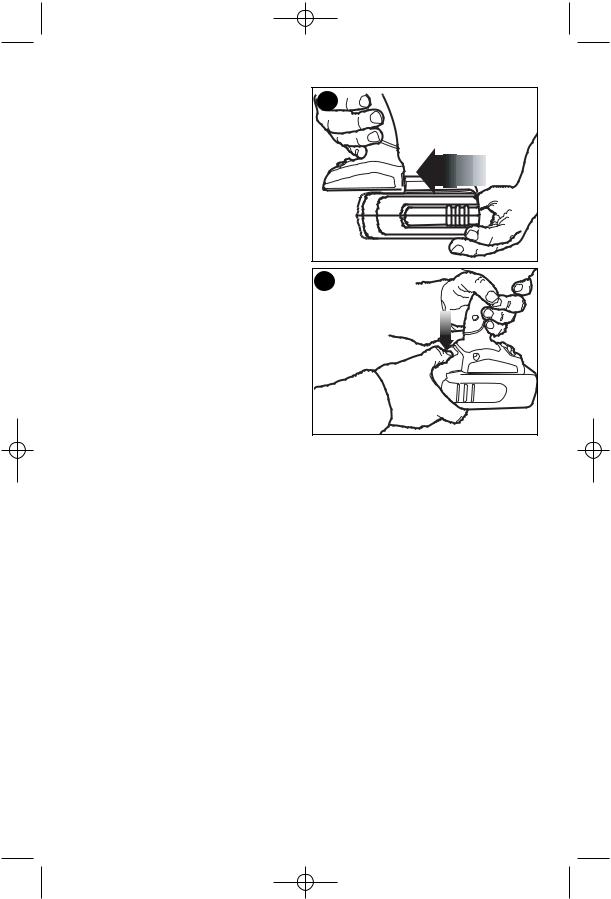
90546221 pc1800l pcl180l 1/5/09 12:34 PM Page 9
INSTALLING AND REMOVING THE BATTERY PACK
TO INSTALL BATTERY PACK: Insert battery |
C |
pack as shown in figure C. |
|
TO REMOVE BATTERY PACK: Depress the |
|
|
battery release button as shown in figure D |
D |
|
and pull battery pack out. |
||
|
OPERATING INSTRUCTIONS
SWITCH
To turn the light on, depress the On/Off switch (1). To turn it off press the switch a second time.
REPLACING THE BULB (FIGURE E)
 WARNING: Shock Hazard. Disconnect battery pack before replacing the bulb. Such preventative safety measures reduce the risk of personal injury.
WARNING: Shock Hazard. Disconnect battery pack before replacing the bulb. Such preventative safety measures reduce the risk of personal injury.
 CAUTION: Burn hazard. Lens or bulb may be hot immediately after use.
CAUTION: Burn hazard. Lens or bulb may be hot immediately after use.
Porter Cable Service Replacement Bulb
Flashlight Catalog Number |
Service Part Number Bulb |
PC1800L, PCL180L |
90534275 |
NOTE: Use only KPR 18V 0.3A Replacement Bulb. |
|
9
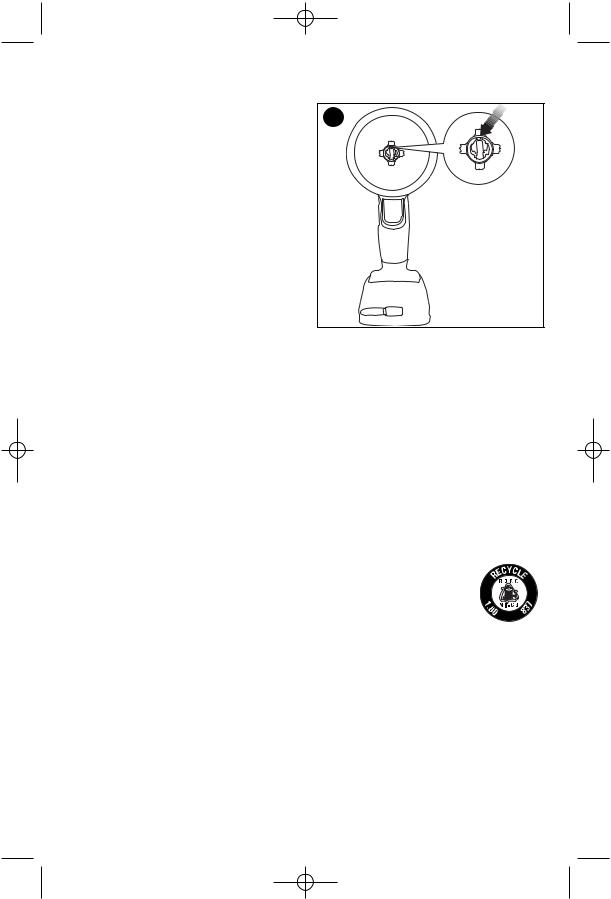
90546221 pc1800l pcl180l 1/5/09 12:34 PM Page 10
To replace the bulb:
1. Unscrew the lens holder (2).
2. Turn the bulb until the triangular cutout on
the rim of the bulb lines up with the triangular E notch shown in figure E.
3.Pull the bulb out and insert a new bulb by lining up the triangular notch and the triangular cutout. Turn the bulb a half turn to lock in place.
4.Reinstall the lens holder
NOTE: Do not look directly into the light beam.
|
|
TROUBLESHOOTING |
|
PROBLEM |
POSSIBLE CAUSE |
POSSIBLE SOLUTION |
|
• |
Light will not illuminate. |
• Battery not installed properly. |
• Check battery |
|
|
|
installation. |
|
|
• Battery not charged. |
• Check battery |
|
|
|
charging requirements. |
|
|
• Light bulb needs replacing. |
• Replace bulb as |
|
|
|
outlined in this manual. |
• |
Battery will not charge. |
• Battery not inserted into charger. |
• Insert battery into |
|
|
|
charger until LED appears. |
|
|
• Charger not plugged in. |
• Plug charger into a |
|
|
|
working outlet. Refer to |
|
|
|
“Important Charging |
|
|
|
Notes” for more details. |
For assistance with your product, visit our website at www.portercable.com for a list of service centers, or call the Porter-Cable Customer Care Center at (888) 848-5175.
THE RBRC™ SEAL
The RBRC™ (Rechargeable Battery Recycling Corporation) Seal on the 

 NI-CD battery (or battery pack) indicates that the costs to recycle the battery (or battery pack) at the end of its useful life have already been paid by Porter-Cable.
NI-CD battery (or battery pack) indicates that the costs to recycle the battery (or battery pack) at the end of its useful life have already been paid by Porter-Cable.
RBRC™ in cooperation with Porter-Cable and other battery users, has established programs in the United States to facilitate the collection of spent NI-CD batteries. Help protect our environment and conserve natural resources by returning the spent NI-CD battery to an authorized Porter-Cable service center or to your local retailer for recycling. You may also contact your local recycling center for information on where to drop off the spent battery.
RBRC™ is a registered trademark of the Rechargeable Battery Recycling Corporation.
MAINTENANCE
Use only mild soap and damp cloth to clean the tool. Never let any liquid get inside the tool; never immerse any part of the tool into a liquid.
10

90546221 pc1800l pcl180l 1/5/09 12:34 PM Page 11
REPLACEMENT PARTS
Use only identical replacement parts. For a parts list or to order parts, visit our service website at www.portercable.com. You can also order parts from your nearest Porter-Cable Factory Service Center or Porter-CableAuthorized Warranty Service Center. Or, you can call our Customer Care Center at (888) 848-5175.
SERVICE AND REPAIRS
All quality tools will eventually require servicing and/or replacement of parts. For information about Porter-Cable, its factory service centers or authorized warranty service centers, visit our website at www.portercable.com or call our Customer Care Center at (888) 848-5175.All repairs made by our service centers are fully guaranteed against defective material and workmanship. We cannot guarantee repairs made or attempted by others.
You can also write to us for information at PORTER-CABLE, 4825 Highway 45 North, Jackson, Tennessee 38305, (888) 848-5175 -Attention: Product Service. Be sure to include all of the information shown on the nameplate of your tool (model number, type, serial number, etc.).
ACCESSORIES
 WARNING: Since accessories, other than those offered by Porter-Cable, have not been tested with this product, use of such accessories with this tool could be hazardous. To reduce the risk of injury, only Porter-Cable recommended accessories should be used with this product.
WARNING: Since accessories, other than those offered by Porter-Cable, have not been tested with this product, use of such accessories with this tool could be hazardous. To reduce the risk of injury, only Porter-Cable recommended accessories should be used with this product.
A complete line of accessories is available from your Porter-Cable Factory Service Center or a Porter-Cable Authorized Warranty Service Center. Please visit our Web Site www.portercable.com for a catalog or for the name of your nearest supplier.
THREE YEAR LIMITED WARRANTY
PORTER-CABLE will repair or replace, without charge, any defects due to faulty materials or workmanship for three years from the date of purchase for tools (two years for batteries). This warranty does not cover part failure due to normal wear or tool abuse. For further detail of warranty coverage and warranty repair information, visit www.portercable.com or call (888) 848-5175. This warranty does not apply to accessories or damage caused where repairs have been made or attempted by others. This warranty gives you specific legal rights and you may have other rights which vary in certain states or provinces.
In addition to the warranty, PORTER-CABLE tools are covered by our:
1 YEAR FREE SERVICE: PORTER-CABLE will maintain the tool and replace worn parts caused by normal use, for free, any time during the first year after purchase.
90 DAY MONEY BACK GUARANTEE: If you are not completely satisfied with the performance of your PORTER-CABLE Power Tool for any reason, you can return it within 90 days from the date of purchase with a receipt for a full refund – no questions asked.
LATIN AMERICA: This warranty does not apply to products sold in Latin America. For products sold in Latin America, see country specific
warranty information contained in the packaging, call the local company or see website for warranty information.
To register your tool for warranty service visit our website at www.portercable.com.
WARNING LABEL REPLACEMENT
If your warning labels become illegible or are missing, call (888) 848-5175 for a free replacement.
The following are PORTER-CABLE trademarks for one or more power tools and accessories: a gray and black color scheme; a “four point star” design; and three contrasting/outlined longitudinal stripes. The following are also trademarks for one or more Porter-Cable and Delta products: 2 BY 4®, 890™,AirAmerica®,AIRBOSS™,Auto-Set®, B.O.S.S.®, Bammer®, Biesemeyer®, Builders Saw®, ChargeAir®, ChargeAir Pro®, CONTRACTOR SUPERDUTY®, Contractor's Saw®, Delta®, DELTA®, Delta Industrial®, DELTAMACHINERY & DESIGN™, Delta Shopmaster and Design®, Delta X5®, Deltacraft®, DELTAGRAM®, Do It. Feel It.®, DUALLASERLOCAND DESIGN®, EASYAIR®, EASYAIR TO GO™, ENDURADIAMOND®, Ex-Cell®, Front Bevel Lock®, Get Yours While the Sun Shines®, Grip to Fit®, GRIPVAC™, GTF®, HICKORY WOODWORKING®, Homecraft®, HP FRAMER HIGH PRESSURE®, IMPACT SERIES™,
11

90546221 pc1800l pcl180l 1/5/09 12:34 PM Page 12
Innovation That Works®, Jet-Lock®, Job Boss®, Kickstand®, LASERLOC®, LONG-LASTING WORK LIFE®, MAX FORCE™, MAX LIFE®, Micro-Set®, Midi-Lathe®, Monsoon®, MONSTERCARBIDE™, Network®, OLDHAM®, Omnijig®, PC EDGE®, Performance Crew™, Performance Gear®, Pocket Cutter®, Porta-Band®, Porta-Plane®, Porter Cable®, Porter-Cable Professional Power Tools®, Powerback®, POZI-STOP™, Pressure Wave®, PRO 4000®, Proair®, Quicksand and Design®, Quickset II®, QUIET DRIVE TECHNOLOGY™, QUIET DRIVE TECHNOLOGY AND DESIGN™, Quik-Change®, QUIK-TILT®, RAPID-RELEASE™, RAZOR®, Redefining Performance®, Riptide®, Safe Guard II®, Sand Trap and Design®, Sanding Center®, Saw Boss®, Shop Boss®, Sidekick®, Site Boss®, Speed-Bloc®, Speedmatic®, Stair Ease®, Steel Driver Series®, SUPERDUTY®, T4 & DESIGN®, THEAMERICAN WOODSHOP®, THE PROFESSIONALEDGE®, Thin-Line®, Tiger Saw®, TIGERCLAW®, TIGERCLAWAND DESIGN®, Torq-Buster®, TRU-MATCH®, T-Square®, Twinlaser®, Unifence®, Uniguard®, UNIRIP®, UNISAW®, UNITED STATES SAW®, Veri-Set®, Versa-Feeder®, VIPER®, VT™, VT RAZOR™, Water Driver®, WATER VROOM®, Waveform®, Whisper Series®, X5®, YOUR ACHIEVEMENT. OUR TOOLS.®
Trademarks noted with ® are registered in the United States Patent and Trademark Office and may also be registered in other countries. Other trademarks may apply.
4825 Highway 45 North
Jackson, TN 38305
(888) 848-5175
www.portercable.com
12
